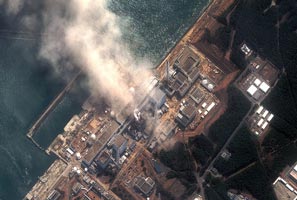
Japan has barely begun responding to Friday's earthquake and tsunami, and already the government has been forced to focus on a potential new catastrophe at the Fukushima Daiichi nuclear power plant (Daiichi can be translated, by the way, as "first" or "number one"). An explosion ripped through a reactor building Monday afternoon (Tuesday morning Japan time)—the third blast since Saturday as workers struggled to deal with pressure buildups in three of the six reactor buildings at the plant. Later, a fire broke out in a fourth reactor building. The new explosion and fire were apparently responsible for a spike in radiation levels around the plant. People living within 20 kilometers (12.5 miles) of the plant complex were ordered to evacuate; those within 30 kilometers (10 miles) were told to stay indoors to avoid radiation exposure. Japanese Prime Minister Naoto Kan addressed the nation after Tuesday morning's blast. "Radiation levels around the compound have risen to fairly high levels," Kan said. "There is a danger of even higher radiation levels."
So: How bad is the Fukushima situation? And will it affect us in California? To the second question, we'll just say: We'd like to know, too, and we're working to find out. (Here's someone who was working even harder: Paul Rogers of the San Jose Mercury News. See his story: So far, very low risk of West Coast contamination from Japanese nuclear accident, experts say.) To the first question: Judging from the coverage it's getting from careful, measured sources, we're led to believe, as most of you are, that it's pretty bad. Here's a selection of headlines:
The Washington Post: JAPAN STEPS CLOSER TO FULL-BLOWN NUCLEAR CATASTROPHE AFTER 3RD BLAST
Yes, the headline is in all caps on the Post's front page. From the story:
The new setbacks came on the heels of a difficult Monday at Fukushima Daiichi unit 2, one of six reactors at the site. Utility officials there reported that four out of five water pumps being used to flood the reactor had failed and that the other pump had briefly stopped working. As a result, the company said, the fuel rods, normally covered by water, were completely exposed for 140 minutes.
That could have grave consequences, worsening the partial meltdown that most experts think is underway. By comparison, in the 1979 Three Mile Island, Pa., nuclear plant accident, it took just two hours for half the plant’s nuclear fuel to melt.
According to a report by the Kyodo news agency, the fifth pump was later restarted, and seawater mixed with boron was again injected in a desperate bid to cool the reactor, but the fuel rods remained partially exposed and ultra-hot. On Tuesday morning, Tokyo Electric said that 2.7 meters, or less than half, of the rods were still exposed.
The New York Times: Japan Faces Potential Nuclear Disaster as Radiation Levels Rise
Japan’s nuclear crisis verged toward catastrophe on Tuesday after an explosion damaged the vessel containing the nuclear core at one reactor and a fire at another spewed large amounts of radioactive material into the air, according to the statements of Japanese government and industry officials.
Los Angeles Times: Reactor breach feared as radiation rises
In the best-case scenario, the situation at the damaged reactors will take weeks, if not months, to stabilize, U.S. nuclear experts said. "They do not have the situation under control," said Robert Alvarez, a nuclear expert at the Institute for Policy Studies and a former Energy Department deputy.
The Wall Street Journal assesses the dangers posed by the crisis at the power plant: Damaged Nuclear Power Plants Could Spew Range of Emissions